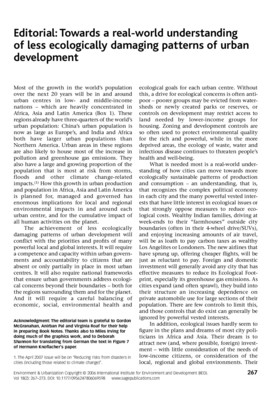Editorial: Towards a real-world understanding of less ecologically damaging patterns of urban development
Document begins: Editorial: Towards a real-world understanding of less ecologically damaging patterns of urban development Most of the growth in the world's population ecological goals for each urban centre. Without over the next 20 years will be in and around this, a drive for ecological concerns is often anti- urban centres in low- and middle-income poor poorer groups may be evicted from water- nations which are heavily concentrated in sheds or newly created parks or reserves, or Africa, Asia and Latin America (Box 1). These controls on development may restrict access to regions already have three-quarters of the world's land needed by lower-income groups for urban population: China's urban population is housing. Zoning and development controls are now as large as Europe's, and India and Africa so often used to protect environmental quality both have larger urban populations than for the rich and powerful, while in the more Northern America. Urban areas in these regions deprived areas, the ecology of waste, water and are also likely to house most of the increase in infectious disease continues to threaten people's pollution and greenhouse gas emissions. They health and well-being. also have a large and growing proportion of the What is ...
Cite this publication
Available at https://www.iied.org/g00501
